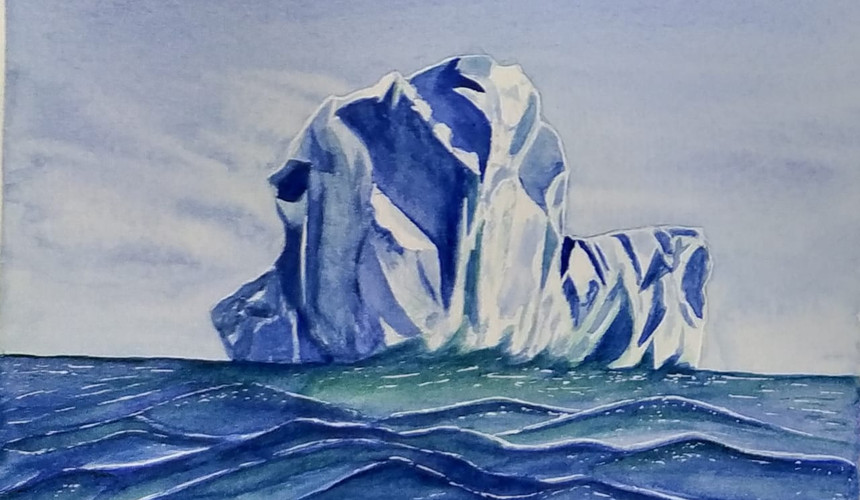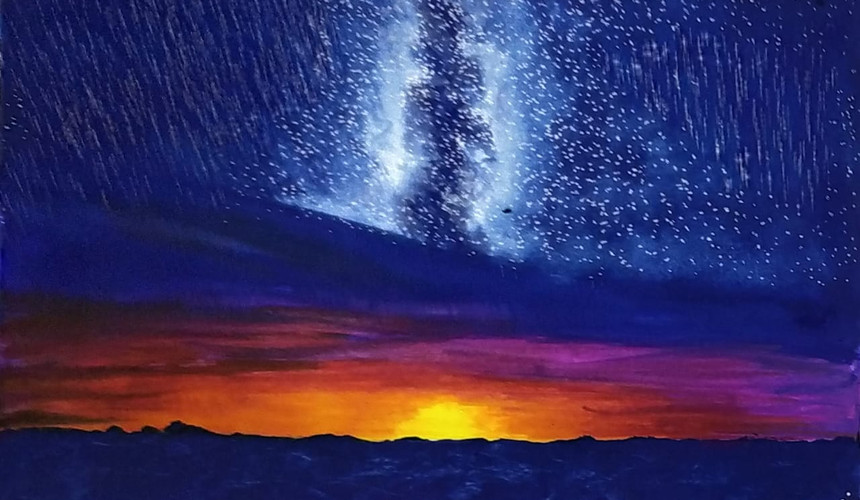Create Unique Watercolor Textures
- Shilpi Gupta

- Aug 22, 2021
- 8 min read
Updated: Mar 11, 2023
We always feel that creating textures using watercolors is very difficult. Textures can only be created using acrylic colors or oil paints or by using palette knife, etc. But that is not true. Here I will show you different textures that we can create using simple techniques with watercolors.
Let's Go
Salt Texture: You can create this texture using dark colors as well as light shades to create a unique background effect.
Paint the area with a watery color.
Before it dries, sprinkle table salt over it by taking a pinch of salt in your fingers.
You can try by adding more salt or less salt too and see the difference. Both ways the texture created is a little different.
The first picture shows salt effect using a dark color. For this you need to take more of fresh paint as well as keep it watery. This might be difficult initially, but you can get it by some practice.
The second picture shows salt effect using a light color. This will be very easy to achieve. Remember that watercolors always become lighter after drying up. So always take a shade darker than you finally want. Especially because you cannot paint once the salt is sprinkled.
The third and fourth pictures show how you can get a different texture by using salt water. Mix salt in little water and give a liberal wash with this water. And then apply your color with thick brush strokes. The color gets mixed up with salt water and gives a unique effect. I tried this on my own and it came out really well. You can create more awesome effects too by trying out variations.
Sponge Texture: You can make this using dark colors as well as light shades to create a soft textured background effect.
Take lots of color and mix it with water.
Keep a good amount of this mixture ready because the sponge can soak a lot of it.
Take a small piece of sponge and dip it in this mixture.
Apply color on your paper by dabbing this sponge softly and continuously at different places.
Dip the sponge again if it dries off and re-apply.
The first picture shows how a beautiful texture has been created using sponge and blue color. This can be used to show clouds or snow in the background.
The second picture shows a similar effect created using sponge and green color. This can be used to show greenery like bushes or forest in the background. You can create more awesome effects too by trying out variations.
Stippling Texture: You can create this with any color you want. Depending on the thickness of the brush u can create different textured backgrounds.
Take lots of color and mix it with little water.
Dip your brush and dab it on paper keeping your brush at an angle of around 45°.
Keep repeating the dabbing or stippling till you have color in the brush.
Then take more color and repeat. And your texture is ready.
The gap that you leave between consecutive dabs should be kept the same to give a consistent look. Keeping more gap or less gap or no gap can each create different textures too. Try out different variations and you will truly enjoy it.
The first picture shows how a beautiful texture has been created using green color and a medium thickness brush with continuous stippling.
The second picture shows a similar effect created using a thick brush and keeping a gap between the consecutive dabs.
Bokeh Effect: A painting can be made with a bokeh effect with either one single color or with shades of one color; or even with multiple colors to give a colorful background.
To create a multicolored bokeh effect, apply one color on paper in a circular shape very lightly creating circles at different places. You don't need to be perfect in the circles. Also some circles can be big whereas some can be small.
Take another color and repeat the same step at different places. Repeat with as many colors as you want.
Now leave it to dry completely. This is a very important step else you might ruin the whole thing.
Now take a small piece of sponge, dip it in clean water and squeeze out the water completely. Using this sponge, make circles on the dried colored paper and lift up the color out of these circles very lightly.
After every circle, you will need to dip the sponge in water again to wash off the lifted color. Repeat the same step multiple times.
These new circles made with sponge can be of various sizes. You can overlap them over the colored circles or even make them elsewhere.
Once these have dried, make new ones overlapping the previous bokeh circles. This gives the best effect.
Leave it to dry and see if it looks fine. One way is that you get a light textured bokeh effect and you leave it as it is.
But if you want them to stand out with dark and bright colors, you need to paint all the areas left outside the sponged circles very carefully. I know it is little time consuming, but the effect created is truly awesome.
The first picture shows a multicolored bokeh effect created by me in the Krishna paintig whereas the second one is single colored. In both these paintings, I have repainted the areas outside the bokeh circles. Beautiful flower backgrounds are created in third and fourth paintings where I have left the light background as it is.
Wet-in-Wet: This is pretty common and most of you must have tried it out. But I will briefly explain it for beginners.
Take a big flat brush and paint clean water on your watercolor paper. Be sure that the paper is moist and it has a shiny texture. At the same time, be sure that there should not be so much water, such that it starts flowing when you tilt the paper.
Now with another brush add wet paint on the moist area and allow it to spread out.
Let it diffuse and disperse on the paper. Keep adding more colors till you get the desired effect.
Wet in wet gives a very soft and blooming kind of effect. It can be used to paint sky or create fog in the distance or things in the background which are out of focus.
To paint finer details, first let the wash dry completely. Else it can mix up and get muddy. Once the background is completely dry, you can start painting your foreground painting with the required details.
The first two paintings show different background effects created by wet in wet technique. The remaining ones have different skies created using this technique. You can check my store gallery to see more of such examples.
Soft Edge Texture: This looks quite elegant and if you follow the steps properly, anyone can do it.
First you need to apply a uniform line of thick color on the paper.
Take clear water and on one edge of the damp color, move your brush in one swoop. Let the color spread to the new wet area that you have created.
Take more clear water and soften the new lighter edge. You can spread it till the area you desire. You will be able to get the effect just by spreading color from one edge of the line itself.
The soft edge texture looks very beautiful. You can use it to create background effect or clouds or just for the sky.
The first two paintings demonstrate how this effect can be used to show sky and snow. The third shows a portrait painting where it is used to create a background wooden bars effect. The fourth uses this technique to create a broken wall effect behind the lioness and the cub.
Cling Film Texture: You just need a cling film (transparent plastic wrap) and your watercolors to create this texture. You can create an awesome wavy effect using this simple technique.
Apply watercolor paint on your paper. Be sure it is quite wet enough.
Place cling film over the wet paint. Very lightly crumple the cling film to form wavy horizontal lines. And leave it for drying.
Cover all the areas similarly where you want to give a wavy effect or a breezy effect. Remember, the most difficult part is to leave it for drying. Do not touch or mingle with it else you can spoil the effect.
Once it is dry, remove the cling film. You will simply get an awesome texture.
The painting of a flamingo is shown above where the waves have been created using cling film. Do check out the video of the flamingo where the breeze is blowing and you can see the waves in the water.
Palette Knife Texture: Yes, a palette knife like texture using watercolor. I was always fascinated by the textures created using oil/acrylic colors and always wondered why we should not be able to do a similar thing using watercolor. I know the properties of each color medium is different...and watercolor is transparent etc etc...But why not try it out.
Here I took a piece of cardboard (of the size you want the textured boxes). You can even use an old credit card / visiting card as it will last longer due to its plastic coating and the same piece can be used to create texture in the whole painting.
Took lots of fresh paint on a paper plate or a flat palette, as you need something flat to pick up the color like we do with a palette knife.
In the first one, along with blue I took a little fresh white paint just by its side and for the Ganesha painting, I took red and little yellow.
Now just take your piece of card, swipe it slowly on the paint such that you touch both the colors, side by side. Note that the paint layer should be thick (no water added to the paint).
Now in one direction, swipe your card on your painting. Go in alternate horizontal and vertical swipes to create this unique texture. Try it out on a rough sheet first. You will just love it.
The first is my painting where I have used it to show water. And in the second one, I have used it to create a beautiful textured background behind Ganesha. I just loved this texture as after drying, you can even touch it and feel it just like acrylic paints.
Do check out the video of the painting where I have shown how to create this unique texture.
Recommendations: I have tried out these unique textures in my paintings. Some are very common and you get tutorials on them. But some of these are not available anywhere and I have tried them on my own. If you follow the step-by-step instructions given above, you will definitely be able to create them. In case you have any queries regarding the same, you can freely ask me in the comments section. I would be happy to help.
Before trying these out, kindly ensure that you are using the right watercolor paper and the right watercolors. You can read my blogs on choosing these in case you need help. I have also given below Amazon links of the right products that you need to create the right watercolor paintings.
Check this video for the Art Materials explanation:
Check this for all the Art Materials links:
Useful Blogs :
Subscribe to my YouTube channel
Visit my Online Art Store
Enroll for my advanced level photorealistic art workshops
Check out my exhibits at India Art Festival
Join me on Instagram
Meet me on Facebook
Link with me on LinkedIn
Mail me on : 23shilpijay@gmail.com

























































Comments